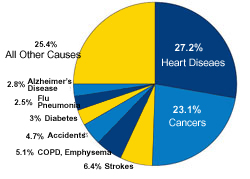Never before have so many people lived for so long. Life expectancy has nearly doubled over the last century, and today there are 36.8 million Americans age 65 and older. The aging of the population — in past decades and in the foreseeable future — presents both a challenge and an opportunity for all of us as we seek to stay healthy throughout our longer lives. This special section presents some of the latest research findings on aging well and offers a checklist of ways to take even greater charge of staying healthy. This section also is a springboard to much more free, authoritative information available at www.medlineplus.gov.

Dr. Richard Hodes
Photo courtesy of NIH/NIA
Welcome to this special section of NIH MedlinePlus on "Aging Well."
Aging well is more critical than ever as America—indeed, the world—grows older. While a significant portion of older Americans has not been able to hold disability at bay, the vast majority of people age 65 and older have maintained their health and are able to keep up with daily activities.
What is the difference between aging well and growing more frail and less independent with advancing years? The National Institute on Aging's (NIA) aim is to learn the factors contributing to a healthy old age and to understand the processes underlying increased risk of disease and disability associated with growing older. NIA's research program covers a broad range of areas, from the study of basic cellular changes with age to the examination of the biomedical, social, and behavioral aspects of age-related conditions, including Alzheimer's disease.
In this special report, NIH MedlinePlus presents some of the key elements that the NIA and its fellow Institutes at the NIH have identified as components of healthy aging. In addition to the brief research-based capsules of information and recommendations presented here, you will find much more, expanded information on all of these topics at MedlinePlus (www.medlineplus.gov) and at the NIA Web site (www.nia.nih.gov). Both Web sites offer links to www.NIHSeniorHealth.gov. You also are invited to call the NIA Information Center toll free at 1-800-222-2225 to obtain a list of publications on aging and health that you can then order free of charge.
We hope that you will find this report useful in your personal efforts toward aging well.
Dr. Richard J. Hodes
Director, National Institute on Aging
Causes of Death in U.S.
The Centers for Disease Control and Prevention (CDC) reported in late 2006 that, for adults, heart disease remains the No. 1 killer; however, deaths from heart disease dropped by 16 percent between 2000 and 2004. During the same period, deaths from the No. 2 killer of adults—cancer— fell by 8 percent. Deaths from diabetes, however, are on the rise. (http://www.cdc.gov/nchs/hus.htm).

